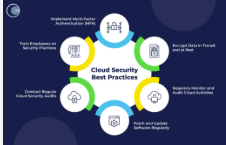The shift to cloud computing has revolutionized the way businesses operate, offering unmatched scalability, flexibility, and cost efficiency. However, as organizations increasingly migrate sensitive workloads to the cloud, security remains a top concern. Data breaches, misconfigurations, and insider threats highlight the importance of robust cloud security practices. Implementing the right strategies can safeguard your business, ensure compliance, and build trust with customers.
This article explores the best cloud security practices to help organizations protect their data, applications, and infrastructure in today’s dynamic digital environment.
Why Cloud Security Matters
Cloud adoption is accelerating, but so are cyber threats. According to a 2024 report by Cybersecurity Ventures, global cybercrime costs are expected to reach $10.5 trillion annually by 2025. With cloud environments being a prime target, securing them effectively is non-negotiable.
Strong cloud security practices help organizations:
- Prevent unauthorized access to sensitive information.
- Maintain compliance with industry regulations like GDPR, HIPAA, and ISO 27001.
- Reduce downtime caused by cyberattacks.
- Build customer trust and protect brand reputation.
Best Cloud Security Practices
1. Implement Strong Identity and Access Management (IAM)
Controlling who can access your cloud resources is the foundation of security. Effective IAM policies reduce the risk of unauthorized access.
Best practices include:
- Enforce multi-factor authentication (MFA) for all users.
- Apply the principle of least privilege (PoLP), granting users only the permissions they need.
- Regularly audit and remove unused or outdated accounts.
- Use single sign-on (SSO) for secure and simplified access.
2. Encrypt Data in Transit and at Rest
Encryption ensures that even if data is intercepted or compromised, it remains unreadable to unauthorized users.
- Data at rest: Use encryption technologies like AES-256 to secure stored data.
- Data in transit: Apply TLS (Transport Layer Security) protocols for secure communication.
- Manage encryption keys using a Key Management System (KMS).
Cloud providers like AWS, Azure, and Google Cloud offer built-in encryption services, making it easier to implement.
3. Secure Cloud Configurations
Misconfigurations are one of the most common causes of cloud breaches. For example, an exposed storage bucket can expose millions of customer records.
How to avoid this:
- Use automated configuration tools to detect vulnerabilities.
- Apply security baselines recommended by providers (e.g., AWS Well-Architected Framework).
- Conduct regular configuration reviews and penetration tests.
- Implement Infrastructure as Code (IaC) to enforce consistent security standards.
4. Monitor and Log Cloud Activity
Visibility is critical to identifying and mitigating threats before they escalate.
- Enable centralized logging for all cloud resources.
- Use Security Information and Event Management (SIEM) solutions to analyze logs.
- Configure alerts for suspicious activities, such as unusual login attempts or data transfers.
- Retain logs in compliance with regulations to support audits and investigations.
5. Regularly Update and Patch Systems
Cybercriminals often exploit outdated software and unpatched vulnerabilities. Keeping your systems updated closes these gaps.
Best practices:
- Automate patch management where possible.
- Apply security updates promptly.
- Use vulnerability scanners to identify risks.
- Test updates in a staging environment before deployment.
6. Educate Employees on Cloud Security
Human error remains one of the weakest links in cybersecurity. Training employees can significantly reduce risks.
- Conduct regular cybersecurity awareness training.
- Simulate phishing attacks to test employee readiness.
- Establish clear policies on cloud usage and data handling.
- Promote a security-first culture across all departments.
7. Leverage Zero Trust Architecture
The Zero Trust model assumes no user or system is trustworthy by default, even inside your network.
Key elements of Zero Trust include:
- Continuous identity verification.
- Micro-segmentation to isolate workloads.
- Strict device compliance checks.
- Dynamic access policies based on user behavior.
Adopting Zero Trust can drastically minimize the attack surface of your cloud infrastructure.
8. Ensure Compliance with Industry Regulations
Non-compliance can result in heavy fines and loss of business credibility.
- Map your cloud security strategy to standards such as GDPR, HIPAA, PCI DSS, and ISO 27001.
- Use compliance tools offered by providers, such as AWS Artifact or Google Cloud Compliance Reports.
- Conduct third-party audits to validate compliance.
9. Backup and Disaster Recovery Planning
Even the most secure cloud environments can experience outages or attacks. A solid backup and recovery plan ensures business continuity.
- Schedule automated backups for critical data.
- Test disaster recovery procedures regularly.
- Store backups in geographically diverse locations.
- Consider a multi-cloud strategy for redundancy.
10. Collaborate with Your Cloud Provider
Cloud security is a shared responsibility. Providers secure the infrastructure, while organizations must secure their applications and data.
- Understand your provider’s Shared Responsibility Model.
- Review Service Level Agreements (SLAs) for security guarantees.
- Leverage provider-native tools like AWS GuardDuty, Azure Security Center, or Google Chronicle for added protection.

Conclusion
As organizations continue to embrace cloud technology, prioritizing security is essential. By adopting best practices such as strong IAM policies, encryption, regular monitoring, employee training, and Zero Trust architecture, businesses can significantly reduce risks and maintain customer trust.
Cloud security is not a one-time task—it’s an ongoing commitment to staying ahead of evolving threats. Start by assessing your current cloud environment, implementing the strategies outlined here, and collaborating with your cloud provider to build a robust security posture.
Next Steps:
If you’re ready to strengthen your cloud strategy, explore our related guides on:
- [How to Choose SaaS Software]
- [Best Cloud Platforms for Business]
- [Top Cloud Storage Solutions 2025]
For further insights, consult authoritative resources such as:
